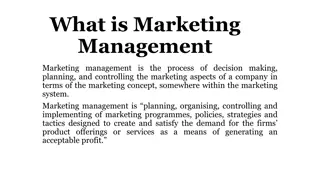Understanding Strategic Planning in Marketing
Explore the key aspects of strategic planning in marketing, including the importance of aligning organizational goals with market opportunities, designing business portfolios, and developing effective marketing strategies. Learn how mission statements guide goal-setting, objective development, and strategy creation to drive business success.
Download Presentation

Please find below an Image/Link to download the presentation.
The content on the website is provided AS IS for your information and personal use only. It may not be sold, licensed, or shared on other websites without obtaining consent from the author. Download presentation by click this link. If you encounter any issues during the download, it is possible that the publisher has removed the file from their server.
E N D
Presentation Transcript
With this we learn. Understand company-wide strategic planning and its four steps. Learn how to design business portfolios and develop strategies for growth and downsizing. Understand marketing s role in strategic planning and how marketers partner with others. Be able to describe the marketing process and the forces that influence it. Learn the marketing management functions, including the elements of the marketing plan.
Strategic planning Strategic planning is defined as: The process of developing and maintaining a strategic fit between the organization s goals and capabilities and its changing marketing opportunities.
Planning activities occur at the business unit, product, and market levels, and include: Defining the purpose and mission Setting objectives and goals Designing the business portfolio Developing detailed marketing and departmental plans
Mission statements should . . . serve as a guide for what the organization wants to accomplish. be market-oriented rather than product- oriented . be neither too narrow, nor too broad. fit with the market environment. be motivating.
Mission statements guide the development of objectives and goals. Objectives are developed at each level in the organization hierarchy. Strategies are developed to accomplish these objectives.
Business portfolio: the collection of businesses and products that make up the company. Designing the business portfolio is a key element of the strategic planning process.
Portfolio Design Portfolio Design 1. Analyze the current business portfolio Identify strategic business units (SBUs) Assess each SBU: The BCG growth-share matrix classifies SBUs into one of four categories using the: Market growth rate SBU s relative market share within the market.
2. Shape the future business portfolio Determine the future role of each SBU and choose the appropriate resource allocation strategy: Build Hold Harvest Divest SBUs change positions over time
Matrix approaches to formal planning share many problems: Difficult, time-consuming, and costly to implement. Focus only on current businesses. Too strongly emphasize market share growth or growth via diversification
Designing the business portfolio also involves: Developing strategies for growth by identifying, evaluating, and selecting promising new market opportunities. Product/market expansion grid Developing strategies for downsizing the business portfolio.
Marketing plays a key role in the strategic planning process. Marketers must practice CRM and Partner Relationship Management. Partnering with other departments in the company as well as other firms in the marketing system helps to build a superior value delivery-network.
The marketing process. Analyzing marketing opportunities The strategic planning and business portfolio analysis processes help to identify and evaluate marketing opportunities. The purpose of the marketing process is to help the firm plan how to capitalize on these opportunities.
Selecting target markets The segmentation process divides the total market into market segments. Target marketing determines which segment(s) are pursued. The market positioning for the product is then determined.
Developing the marketing mix Competitor analysis guides competitive marketing strategy development. Strategy leads to tactics by way of the marketing mix: The Four Ps product, price, place, promotion (seller viewpoint) The Four Cs customer solution, cost, convenience, and communication (customer viewpoint)
Managing the marketing effort Marketing analysis Provides information helpful in planning, implementation, and control Marketing planning Strategies and tactics Marketing implementation Turns plans into action Marketing control Operating control Strategic control Marketing audit
























